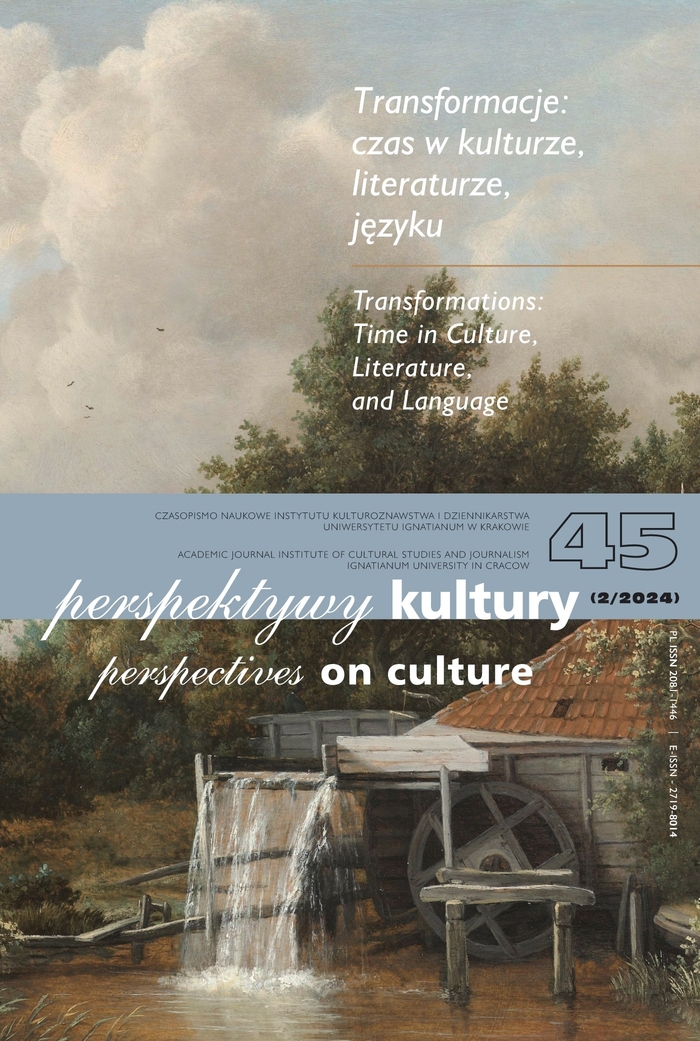Entropic Transformations and Time in Thomas Pynchon’s Early Fiction
Abstract
The paper examines entropy in its relation to time in Thomas Pynchon’s second novel, The Crying of Lot 49. It approaches this complex relation by examining how transitions from order to disorder affect narrative representations of time and temporal experience in the novel. The paper argues that Pynchon’s creative use of entropy consists in the delineation of the concept as distinct from mere stasis or cyclical repetition and in its application of the concept to the poignant portrayal of irreversible transformations of lived time and “local temporalities.” Time in The Crying of Lot 49 does not merely flow at different rates but also thickens or gets dispersed. Correspondingly, the novel portrays alternative temporalities as local niches, positioned ‘sideways’ in relation to the primary narrative frame of the text. In projecting these alternative temporalities, Pynchon’s narrative resorts to imaginative strategies capable of deconstructing the time of empirical reality by means of temporal reversals and simultaneity.
References
Azarian, B. (2022). The Romance of Reality. Dallas, TX. BenBella Books.
Dalsgaard, I. (2012). Science and Technology. In: I. Dalsgaard, L. Herman, B. McHale (eds.), The Cambridge Companion to Thomas Pynchon. Cambridge, Cambridge University Press, 156-167.
Grant, J. K. (1991). Not Quite so Crazy after all These Years: Pynchon’s Creative Engineer. Pynchon Notes 28-29, 43-53.
Letzler, D. (2015). Crossed-Up Disciplinarity: What Norbert Wiener, Thomas Pynchon, and William Gaddis Got Wrong about Entropy and Literature. Contemporary Literature 56(1), 23-55.
Mendelson, E. (1978). The Sacred, the Profane, and The Crying of Lot 49. 1975. In: E. Mendelson (ed.), Pynchon: A Collection of Critical Essays. Englewood Cliffs, NJ: Prentice-Hall, 112-46.
Misztal, A. (2019) Time and Vision Machines in Thomas Pynchon’s Novels. Frankfurt. Peter Lang.
Misztal, A. (2020). Dream time, modality, and counterfactual imagination in Thomas Pynchon’s” Mason & Dixon”. Polish Journal for American Studies, 37-55.
Pynchon, T.(1984, Oct 28). Is it O.K. to Be a Luddite? The New York Times Book Review, 1, 40-41.
Pynchon, T.(1985a). Entropy. In: T. Pynchon, Slow Learner: Early Stories. 1984. Boston: Back Bay Books, 1985. 79–98.
Pynchon, T. (1985b). Introduction. In: T. Pynchon, Slow Learner: Early Stories. 1984. Boston: Back Bay Books, 1–23.
Pynchon, T. (1986). V. 1963. New York: Perennial.
Pynchon, T. (1995). Gravity's Rainbow. 1973. London: Penguin Books.
Pynchon, T. (1993, June 6). Nearer, My Couch, to Thee. The New York Times Book Review, 3, 57.
Pynchon, T. (1999). The Crying of Lot 49. 1966. New York: HarperCollins.
Pynchon, T. (2009). Inherent Vice. London: Jonathan Cape
Rezaei, H., & Samani, M. A. (2012). The Chaotic World and the Entropic Crisis in Thomas Pynchon’s The Crying of Lot 49. Journal of Foreign Language Teaching and Translation Studies 1, 83-98.
Schuber S.P. (1983). Rereading Pynchon: Negative Entropy and ‘Entropy.’ Pynchon Notes 13 (1983): 47–60.
Smith, M. & Tólólyan, K. (1986). The New Jeremiad: Gravity’s Rainbow. 1981. In: H. Bloom (ed.) Thomas Pynchon, New York: Chelsea House, 139-155.
Tanner, T. (1971). City of Words: American Fiction, 1950–1970. New York: Harper.
Turner, F. (2023). Turns and Turnings: the Dynamics of Logogenesis [unpublished manuscript], The University of Texas, Dallas.
Thoreen, D. (1992). The Economy of Consumption: The Entropy of Leisure in Pynchon’s Vineland. Pynchon Notes 30-31, 53-62.
Wiener, N. (1954). The Human Use of Human Beings: Cybernetics and Society. 1948. Boston: Houghton Mifflin.
Copyright (c) 2024 Perspectives on Culture

This work is licensed under a Creative Commons Attribution-NoDerivatives 4.0 International License.
Autor, zgłaszając swój artykuł, wyraża zgodę na korzystanie przez Wydawnictwo Uniwersystet Ignatianum z utworu na następujących polach eksploatacji:
- utrwalania utworu w formie papierowej, a także na nośniku cyfrowym lub magnetycznym;
- zwielokrotnienia utworu dowolną techniką, bez ograniczenia ilości wydań i liczby egzemplarzy;
- rozpowszechniania utworu i jego zwielokrotnionych egzemplarzy na jakimkolwiek nośniku, w tym wprowadzenia do obrotu, sprzedaży, użyczenia, najmu;
- wprowadzenia utworu do pamięci komputera;
- rozpowszechniania utworu w sieciach informatycznych, w tym w sieci Internet;
- publicznego wykonania, wystawienia, wyświetlenia, odtworzenia oraz nadawania i reemitowania, a także publicznego udostępniania utworu w taki sposób, aby każdy mógł mieć do niego dostęp w miejscu i czasie przez siebie wybranym.
Wydawca zobowiązuje się szanować osobiste prawa autorskie do utworu.





